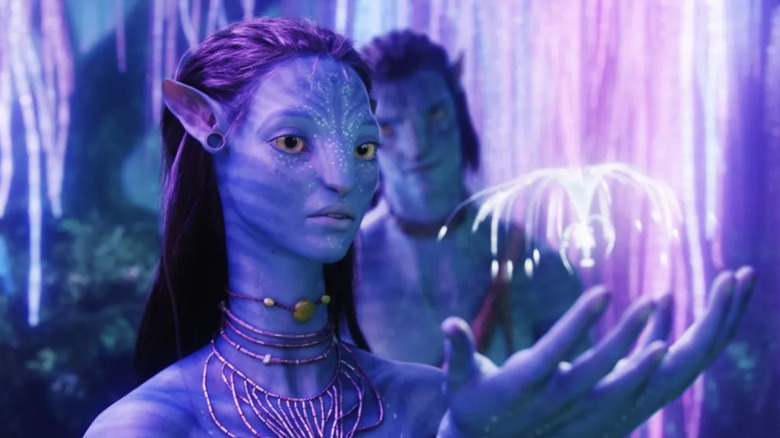Why Avatar Made Some Fans Physically Sick In Theaters
When James Cameron's "Avatar" hit theaters in 2009, the film was considered a cinematic marvel. Cameron and 20th Century Studios spent months marketing the film not just as a film, but an "experience," one that could only be truly appreciated by seeing the film in 3D and IMAX. The story of "Avatar" has been jokingly referred to as "'Dances with Wolves' in space," but anyone buying a ticket for "Avatar" in 2009 already knew that. Audiences weren't tuning in for this weird, white-savior sci-fi fantasy for story, they were there for the spectacle. Credit where it's due, "Avatar" is as visually striking as promised, and the attention to detail paid when crafting the extrasolar moon of Pandora and the designs of the Na'vi is genuinely remarkable.
"Avatar" truly was in a league of its own in terms of cinematic technological advancements. The late and legendary film critic Roger Ebert called the film "a technical breakthrough," and Anne Thompson of IndieWire calling it "a joyous celebration of story craft and the visual possibilities of cinema." Even those most vocally critical of the film's lackluster storyline were kind enough to highlight the film's technical prowess, further cemented by its Academy Award wins for Best Art Direction, Best Cinematography, and Best Visual Effects. The film was also nominated for Best Picture and Best Director, but lost both awards to "The Hurt Locker" and the film's director, Kathryn Bigelow. For as much as the visuals have been praised over the years, there's one major problem with crafting a film of this scope — it runs the risk of making some viewers physically sick.
What is vergence-accommodation?
3D movies are a fantastic way to captivate an audience, but for those that experience vergence-accommodation (now called 3D motion sickness), it can be an utter nightmare. Vergence-accommodation is the name for the mismatched cues received by your brain as your eyes try to process the distance of a virtual 3D object, and the focusing distance required for the eyes to "place" the object. In many instances, people are unable to send cohesive cues to the brain to figure out what the object is and how far away it is due to the 3D image existing on a different visual plane than the actual movie screen, and the eye/mind's constant attempts to recalibrate can result in headaches and feelings of nausea and dizziness. In some extreme cases, it can even trigger vomiting or in the case of one man in Taiwan, death.
"Avatar" was not the only instance of 3D from around the turn of the aughts to cause this phenomenon, as Nintendo had similar complaints following the release of their handheld Nintendo 3DS console. Entertainment presented in 3D was few and far between around this time period, and the eyes of most viewers hadn't been bombarded with constant visual stimuli or ultra high-definition imagery the way they are now. Unfortunately, there is no "cure" for 3D motion sickness, but society is in a much better place to consume 3D media like the upcoming "Avatar: The Way of Water" than we were in 2009.
How to combat 3D motion sickness
For those that feel the effects of 3D motion sickness, there's good and bad news. First, the bad: 3D and high-definition visuals are far more common today than they were in 2009, and our dependence on screens has skyrocketed. But now, the good: if there's still a concern about possibly getting sick in the theater, here are a few tips that might help.
- Closing one eye (RealD 3D glasses work even with only one eye).
- Sitting as far back and in the middle as possible in the theater.
- Fixating your gaze to the part of the screen that is in focus and avoiding the out-of-focus or background elements.
- Most importantly, do not take the 3D glasses off. As much as it seems like it may be a good idea, the constant adjustment and readjustment for your eyes will only make things worse.
Unfortunately according to the American Optometric Association, roughly 16% of people are affected by something called 3D vision syndrome, due to conditions like amblyopia (lazy eye), strabismus (eye turns), convergence insufficiency, and convergence excess. The only real treatment in these cases is vision therapy but chances are, if you're in this 16% of people, this isn't new information.
"Avatar: The Way of Water" debuts in theaters on December 16, 2022.


